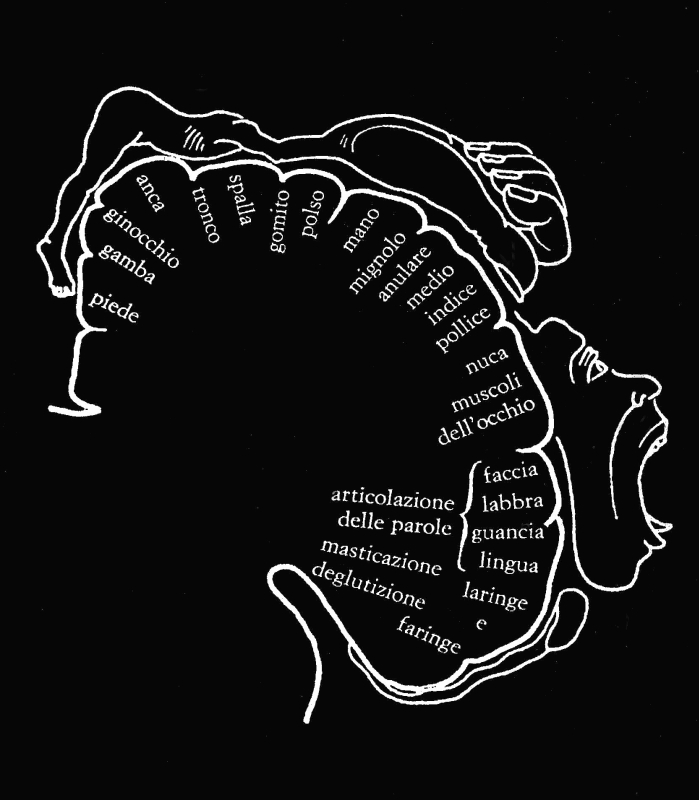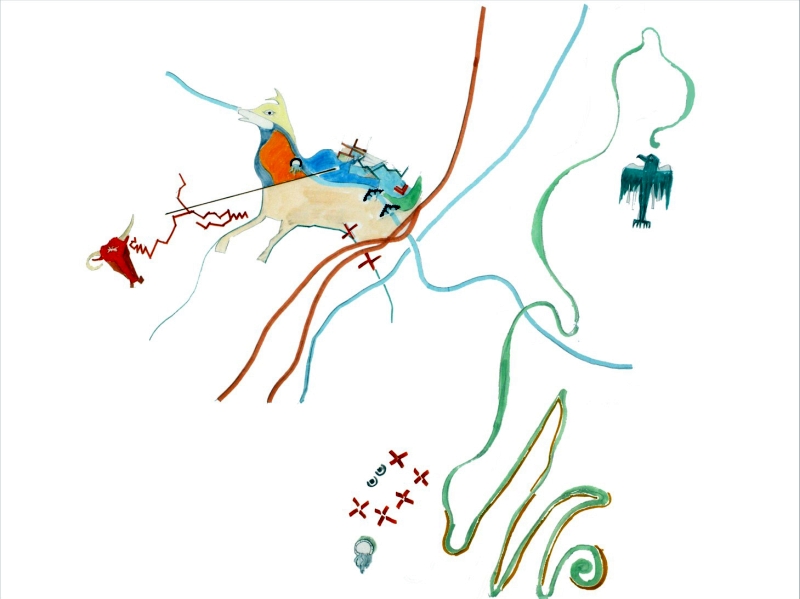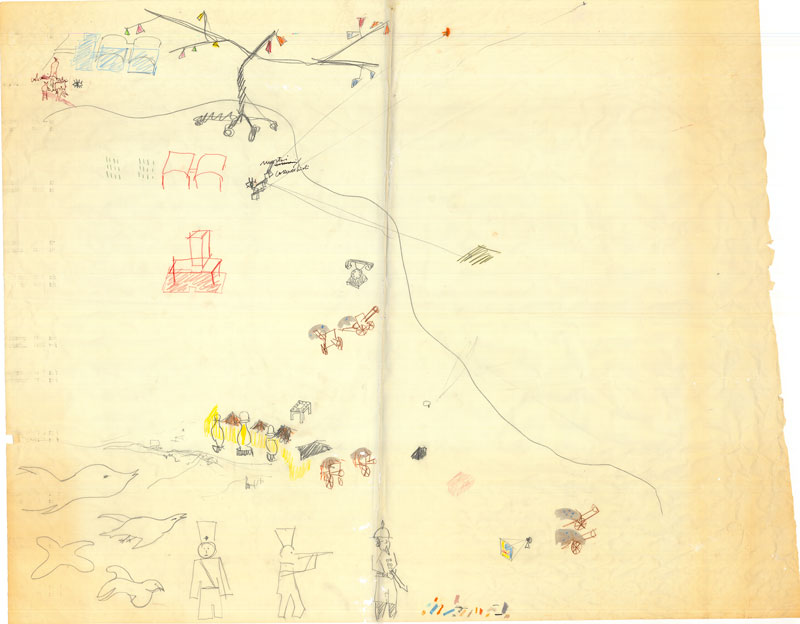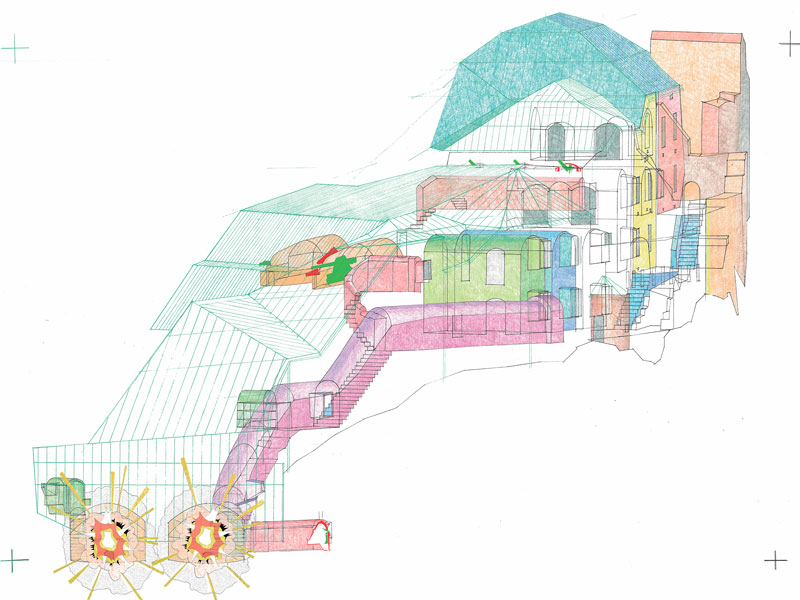In what sense architecture is complex: the role of drawing in
architectural design
Lamberto Amistadi
Fig.
1 - Diagram of the central sulcus (Rolandic Fissure).

Fig.
2 - L. Semerani, The fortified landscape: places and figures. Project
for the valorisation of the historical-monumental heritage of the Valle
del Chiese high lands, 2004.

Fig.
3 - L. Semerani, The fortified landscape. Study design for the setting
up of the Fort Corno “Poetic reaction machine”,
2004.

Fig.
4 - L. Amistadi, Fort Corno. Simultaneous viewing, 2009.

The diagram of the central sulcus (or Rolandic Fissure) shows
us
that among all the functions controlled by the human brain, those of
speech and the movement of the hands alone occupy two-thirds of the
cerebral cortex.
Language and manipulation that changes the state of things, in
other
words, language and technique, are the most important faculties that
humankind has acquired and refined over the course of its evolutionary
history. For Roland Barthes (1982), writing (the morpheme) precedes the
use of the word (the phoneme). Ernst Gombrich (1978) told us about the
magical origin of language, about how for primitive men, in prehistoric
times, the drawing of a bison on the walls of a cave was not a
representation of the bison, but instead represented the
‘receivable’ of the following day’s hunt.
Originally,
the depiction of a thing, the symbolic representation and the thing
itself were coincident. They coincided until the moment when the naming
process assigned a certain name to that particular thing and then, in
the evolution of the abstraction process, the objects were grouped into
classes according to a certain selection filter.
Writing – Architecture
As a discipline, architecture has its own nomenclature. Being
history-based, this nomenclature is fixed and stable. So fixed that if
one had to grasp the nature of a thing from the metaphorical and
instrumental use made of it, it would be impossible to err: the
nomenclature has always been used to represent conditions of stability,
and at the same time to represent and build these conditions. The
example of mnemotechnics is well known as the art of simultaneously
remembering as many objects (things or words) as possible and their
relationship; Ramon Llull (Rossi 1960) indicated in a work of
architecture (as a sequence of neatly distributed rooms) or in a city
part (as an ordered sequence of public places correlated by streets and
arcades) the «structura fixa» within whose
recognizable
places the objects to be remembered are arranged. Retracing these
places with the mind, their image associated with that of the objects
located within them, will immediately result in them being recollected.
Recalling Aldo Rossi’s (1990) definition of
architecture as a
«fixed scene» in which the events of collective and
individual life stand forth, we can already arrange a first order of
conclusion: it is possible to run along a double axis or two axes, one
in time and one in space.
The axis of time is the one which Cassirer spoke of in 1942 at
a
conference entitled «Language and Art II». There he
explained how, with respect to the process of naming that proceeds by
abstraction from the thing to the concept of the thing and evolves to
make the semiotic universe in which we live more and more complex, with
the risk of moving away from an understanding of the original or
producing concepts with no concrete referent, the only people able to
regain possession or let us regain possession of an authentic
relationship with things are the artists. They behave either like
children or like primeval peoples, that is, they are able to travel
backwards through the evolutionary process, running backwards along the
axis of time of history or along the axis of individual time
–
for Queneau (1967) – of both general and particular history.
The axis of space is semiotic, and is the one which covers the
extension to which the metaphors of architecture as a
«structura
fixa» for Llull and as a «fixed scene»
for Rossi
refer. Ramon Llull was one of the precursors of modern formal logic; to
him the city or the areas of the city were of interest as a
well-ordered relationship between the elements of the parts that
constitute it. Aldo Rossi was interested in the city as a set of works
of architecture built within the city and that in turn built it: he was
interested in monuments as «memorable
representations» and
therefore as «formed objects».
Whether used to represent abstract relationships between parts
or to
mount the formed objects in the city, we can enjoy the possibility of
moving freely along the axis that extends from the deeper structure to
the surface, composing images defined once and for all, or rearranging
their syntactic links at a profound level.
Naturally, we cannot be interested in the chronology of the
historical evolution or the developments of these two processes, but we
can allow ourselves to be simultaneously spontaneous like young
children, instinctive like primeval peoples, as sophisticated and
distant as a dandy, complex, simple, evolutionary like the Germans, or
superficial like the Greeks, «out of profundity!»
(Nietzsche 2002).
The (super)technique of drawing
We are not interested in insisting on the linguistic condition
of
architecture, that is, on the fact that architecture is a language,
which has its own words and syntax just like a written language, but on
the equal and opposite thesis of the architectural nature of language
or on its technical nature, and on architecture as the original matrix
of this technical nature.
If it is true that, originally, concrete acts preceded
abstractions,
then the work of the hand that draws with a bison the concept of a
bison, if for Wittgenstein (1999) «architecture is a
gesture», then it is worth considering the research of an
English
scholar, Edmund Hussey (1977), who referred the origin of the word
“structure” to the Greek word “harmozein”,
which offers different meanings: fit together, convention, agreement.
This word was used for the first time by Homer in the Iliad to indicate
the concrete fitting together of the parts in wooden constructions,
that is, using carpentry, whose tectonics, for Semper (1992) is art. Or
Greimas and Courtes (1986), who observed that discursive know-how is
not so very different from the know-how of a shoemaker.
The analogy between architecture and writing, of which
architecture
seems to be not only a metaphor but also an archetypal reference, is
based on the convention which establishes the correspondence between
words and things, discipline by discipline. This analogy makes it
possible to compose the relationship between words, placing it
simultaneously, instantly, magically between the things to which the
words refer; Nelson Goodman (1947) spoke of «constructive
nominalism».
Unlike other disciplines, however, architecture does so with a
greater awareness. This awareness derives from the fact that the
process of history underlying this relationship is continually reminded
of it by the fact that, by its very nature, it is forced to retrace it
afresh each time, to repeat it. In fact, it makes a complete circle
around itself, having to return to the phenomenological universe
concrete objects, formalized starting from its theoretical apparatus:
the parts of architecture that had been transferred into nameable signs
having to be reinstated in the form of works of architecture.
This mobile circle, which perpetuates the repetition of the
architectural event/work by the work of architecture, each time
different and each time fresh, on the one hand strengthens faith in the
verisimilitude of the analogy and on the other enhances the tools that
this awareness makes available, that is, its productive potential. The
enhancement concerns the ability to adumbrate the architectural
project, or rather, the ability of the architect to adumbrate the work
of architecture in the architectural design process.
An increase in this skill set is based on a correspondence and
has a
corollary: the correspondence is the one we have already underlined
between the thing, the name of the thing, and the representation of the
thing, that is, between the thing and the representation of the thing,
the thing and the symbol, at various levels, from the deepest to the
most superficial; the corollary is that the position of the
relationships between things/symbol, that is, architectural design, can
be reduced to a process of composition, to the arrangement of such
things/symbols on the undifferentiated field of the drawing sheet.
Complexity: an example
As we know, a symbol is a particular representation of a
thing. It
is a type of representation that refers to its icastic potential
(Semerani 2000). The symbol is, in other words, a representation of
meaning.
When Denis Cosgrove (1990) spoke of a «symbolic
landscape» the first thing he told us was that the landscape
is a
formed object, but then he also said something about the nature of such
a formation: that it is a self-representation, through which a society
represents to itself and to others the relationships which give it
structure. The reflexive nature of the term indicates the activation of
a self-recognition device: the relationships that structure a society
which the landscape as a symbol represents and signifies are its common
and shared values.
Antonio Monestiroli [1] was
correct when he said that it is essential to agree on the goal. The
goal should be such as to demonstrate to sceptics the topicality of a
piece of architecture, its usefulness. In what way? By exemplifying its
specific potential to syncretically represent within a formal
construction the values common to a given «linguistic
community» (as Gadamer stated, 1985), playing on the
extremely
subtle limit between evidence of recognizability and planning or
prophecy (Picasso’s answer when asked why his portrait of
Gertrude Stein did not look anything like her applies here:
«It
doesn’t matter, it will look like her»).
The fact is that such a representation must be constructed and
this
construction must be understood at all levels, logical, semiotic and
technical.
Let us take an example. In a valley of the Trentino region the
population’s feeling of belonging to the same cultural
community
needs to be represented: this feeling is firstly historical, nourished
by the collective memory, as a product of the individual memories, both
oral and written, of the members of that population. The history that
unites them is largely that of an effort to emancipate themselves from
the material miseries which the poverty of the soil foisted upon its
inhabitants; fatigue, misery, but also creativity and the courage of
the protagonists of numerous individual events. At a certain point,
this local history was impacted by the events of the Great War, which
interwove their universal destiny with the particular one of the
shepherds and peasants/soldiers, their women, mothers, wives and
girlfriends, the elderly and the young children of the mountains. The
literary transcriptions of popular feelings, the real and fictional
stories, and the anecdotes became muddled with the minor and major
events of the war, which afforded a global face to the grotesque
representations that popular legends give of the unpredictability of
humankind’s destiny.
Like the scars of an individual experience, history marked
this
territory with traces of the events it produced. This particular
territory is scattered with objects of a military nomenclature (the
«nomina sunt res» always applies, Semerani 2003):
fort,
casemate, observation post, bunker, artillery post, trench, tunnel. The
task of architecture is to establish original relationships between
existing objects: its difficulty and complexity lies in the type of
originality, which precipitates within the syncretic relationship
between the fact experienced and the reading model. The first reason
for complexity concerns the choice of theme or themes. The assumptions
of Aldo Rossi (1967) – «We are in favour of
‘a-priori’ architecture» – or
of De Chirico
– «The virgin mind is blind» –
apply. The
method is, once again and always, «Goethean», that
known as
«objective fantasy» (Goethe 1807), and belongs to a
faculty
of the mind, the associative one.
Is there a place in the collective imagination of a set of
literary
and artistic representations of a given fact, that is, images described
and depicted, which contains formal units composed of said sets of
named objects? Not directly. However, we can think of the fortress as a
war machine and we can then ask – what kind of machine and
what
kind of war? Of course a machine is a machine and a war is a war, but
oddly enough there is literature which associates the machine with war,
and especially with the Great War. There are machines with a
«spectacular and wonderful effect» that describe
war as
serving loneliness and death. Or rather, there is an artistic
literature which associates the machine with war precisely as a
producer of loneliness and death, and of alienation. Such machines are
wonders of science and structurally represent the power relations of
which they are an expression. The «torture machine»
(Szeemann 1989) of Kafka’s In the Penal Colony
has,
like other «celibate machines», an upper floor, a
place of
power and military authority and a lower floor, where the victim, a
soldier of the Austro-Hungarian Empire convicted of insubordination, is
lying on his stomach while the perfect mechanism of a pantograph
transcribes a sentence from the hand of the designer/executioner to the
skin of the soldier/victim using a harrow-like device. In
«Locus
Solus» by Raymond Roussel, the military authority makes use
of
the prodigious weather calculations of the scientist Canterel.
It is easy to translate the prodigious weather calculations
into the
mathematics of ballistic true-range multilateration on which the
distances and embrasures of the stronghold of Forte Corno were
measured. It is more difficult to question the character that this
reactivation of signs and meaning should produce. Because if it is true
that war machines produced loneliness and death, it is also true that
they are still machines with a «wonderful and spectacular
effect», to such an extent that the reproduction of the
mechanism
has always fascinated children’s games. And it is true that
the
lightness of certain daily occupations can be poetically transcribed:
the place from which the messages of the carrier pigeons depart becomes
the scene of a poetic-sentimental idyll if hope fills the transcription
of the carrier pigeon/dove of peace.
The signs of military nomenclature make up a swathe of
(fortified)
landscape in which they are confused with and flanked by environmental
pre-existences bearing other common nouns (waterfall, stream, cliff,
rock) as well as proper nouns (Revegler, Marach, Cavalla, Pur), which
refer to further «absences» of reference, to other
landscape «clichés» or narrative
stereotypes:
Hirschfeld (Schepers 1980) classified the landscape according to the
nature of the place («Angenehme, muntere, heitere
Gegend und
Garten, Sanft melancholische Gegend und Garten, Romantische Gegend und
Garten, Feirliche Gegend und Garten»); Edmund
Burke (1757)
counted among the elements that characterize the sublimity of a place
«the Sounds and the Roar of waterfalls» and among
the
images of Vastness, the high rocks, the vertical precipices, the rough
and broken surfaces. William Kent (1987) gave shape to these literary
suggestions by drawing or building them: on the top of the rock
delimiting the waterfall stands the temple of the god who personifies
it. The caves that populate romantic landscapes are those of a sleeping
nymph, rather than the dwelling of the god of the river that crosses
them; if the short imperfect vault of the military tunnel dug on the
northern limit of the park becomes a grotesque representation of the
end of an initiatory path, the circle then closes: the labours, the
adventures, the sufferings of the past exalt in the light of awareness
and in the story of the goals that the resoluteness of a common effort
and the will to live have been able to draw from the unpredictable and
tragic.
However, we do not think, as Marcella Aprile (1993) did, that
the
landscape of narration is a landscape composed of, or in, fragments,
but rather that it indicates, as always, the idea of a succession of
independently defined parts. The structure of a narrative will
determine the mutual location of the parts or their
«interesting
distance».
Henry Focillon (1990) spoke of the power of concentration of
the
hand. Which is also a drawing technique: before sliding your hand over
the sheet you must visualize with the eye of the mind the completed
image of whatever you need to represent. And this is why I believe that
transmissibility is physiognomy: the succession that ranges from the
choice of the theme to the determination of the figures that will
represent it, to their representation in the correct reciprocal
position concerns a narration of the expression, punctuated by
wrinkling of the forehead, false starts, the relevance and resoluteness
of the gesture, all given rhythm by the suspensions and silences from
which the assertions appear by negation. I have always been fascinated
by the way in which some artists/intellectuals/architects compose on a
blank sheet a list of determinations, in the form of a word or a
symbolic figure, and whether it is the design of a conference, rather
than a museum installation or a work of architecture, a house, a
palace, a city, compact or «wide open spaces», in
extension
or subsequent.
For me, this is not a graphic fascination, but the fragile and
instantaneous appearance of a utopia, its still possible staging.
Utopia is already that «Albertian» one of a
principle of
order or economy, in the sense of Tessenow, but is even better
expressed with a touch of melancholy by Ludwig Wittgenstein (1999, p.
27): «Civilization is like a great organization, which
indicates
to whoever belongs to it the place where he/she can work in the spirit
of the whole, and its strength can rightly be measured according to the
result obtained by it in the sense of the whole. But in an age, like
ours, of non-civilization, the forces are in pieces and the strength of
the individual is consumed by opposing forces and frictional
resistances, and cannot find expression in the length of the road
travelled, but perhaps only in the heat generated by overcoming these
resistances. Energy, however, remains energy, and even if the spectacle
that this era offers is not that of the becoming of a great work of
civilization, in which the best collaborate towards the same grand
objective, but the unedifying spectacle of a multitude where the best
pursue only private ends, we must never forget that it is not the show
which matters most.
And although it is very clear to me that the disappearance of
a
civilization does not mean the disappearance of human value, but only
of certain ways of expressing it, the fact remains that I consider the
current of European culture without sympathy, and I cannot understand
its ends, if any exist».
Notes
[1]
Seminar lecture by Antonio
Monestiroli as part of the PhD course in Architectural Composition of
the Department of Architectural Design of the IUAV on the occasion of
the presentation of his book entitled: La metopa e il
triglifo: nove lezioni di Architettura.
Laterza, Rome 2002.
References
APRILE M. (1993) – Dal giardino al
paesaggio. Flaccovio, Palermo.
BARTHES R. (1982) – Il grado zero della
scrittura. Einaudi, Turin.
BURKE E. (1757) – A Philosophical Enquiry
into the Origin of Our Ideas of the Sublime and Beautiful.
CASSIRER E. (1942) – “Linguaggio e arte
II”. In: Id. (1981) – Simbolo, mito e
cultura. Laterza, Rome-Bari.
COSGROVE D. (1990) – Realtà
sociali e paesaggio simbolico. Unicopli, Milan.
FOCILLON H. (1990) – Vita delle forme,
seguito da Elogio della mano. Einaudi, Turin.
GADAMER H. G. (1985) – Verità
e metodo. Bompiani, Milan.
GOETHE W. (1807) – “Sollecitazione
significativa per una sola parola intelligente”. In: Id.
(1983) – La metamorfosi delle piante. Guanda,
Parma.
GOMBRICH E. (1978) – Arte, percezione,
realtà. Einaudi, Turin.
GOODMAN N., QUINE W. V. (1947) – “Verso un
nominalismo costruttivo”. In: Id. (1967) – La
filosofia della matematica. Laterza, Bari.
GREIMAS A. J., COURTES J. (1986) – Semiotica
Dizionario ragionato della teoria del linguaggio. La casa
Usher, Florence.
HUSSEY E. (1977) – I presocratici.
Mursia, Milan.
KENT W. (1987) – Landscape garden
designer: an assessment and catalogue of his designs. A.
Zwemmer Ltd, London.
NIETZSCHE F. (2002) – La gaia scienza.
UTET, Turin.
QUENEAU R. (1967) – I fiori blu.
Einaudi, Turin.
ROSSI A. (1967) – “Introduzione a
Boullèe”. In: Id. (1978) – Scritti
scelti sull’architettura e la città, 1956-1972.
Città Studi, Milan.
ROSSI A. (1990) – Autobiografia
scientifica. Pratiche, Parma.
ROSSI P. (1960) – Clavis Universalis,
Arti mnemoniche e logica combinatoria da Lullo a Leibniz.
Ricciardi, Milan.
SCHEPERS W. (1980) – Hirschfelds theorie
der Gartenkunst. Werner’sche Verlagsgesellschaft
Mbh., Worms.
SEMERANI L. (2000) – “Il parco
metropolitano del nord-est”. In: QUINTELLI C. (edited by), S.S.9
via Emilia: progetti architettonici e nuovi luoghi lungo la via Emilia
tra città e città. Abitare Segesta,
Milan.
SEMERANI L. (2003) – “Interno veneziano
(elogio della
sezione)”. In: Quaderno del Dottorato di ricerca in
Composizione
architettonica del dPa dipartimento di Progettazione architettonica,
IUAV, 17, February.
SEMPER G. (1992) – Lo stile nelle arti
tecniche e tettoniche, o Estetica pratica: manuale per tecnici, artisti
e amatori. Laterza, Rome.
SZEEMANN H. (1989) – Le macchine celibi.
Electa, Milan.
WITTGENSTEIN L. (1999) – Osservazioni
filosofiche. Einaudi, Turin.



